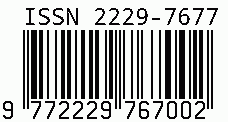
International Journal on Science and Technology
E-ISSN: 2229-7677
•
Impact Factor: 9.88
A Widely Indexed Open Access Peer Reviewed Multidisciplinary Bi-monthly Scholarly International Journal
Plagiarism is checked by the leading plagiarism checker
Call for Paper
Volume 16 Issue 4
October-December 2025
Indexing Partners



















Quantum Mechanics Based “Designed to Dissolve” Materials to Minimize Electronic Waste
| Author(s) | Mr. Siba Ram Baral |
|---|---|
| Country | India |
| Abstract | The global electronic waste (e-waste) crisis has gradually converted e-wonderland into e-wasteland. This linear 'take-make-dispose' design philosophy poses an intractable threat to environmental stability and resource security. Current end-of-life strategies, including conventional recycling and state-of-the-art transient electronics, are fundamentally inadequate, limited by inefficiency, hazardous byproducts, and reliance on non-specific, insecure degradation triggers. This paper introduces a paradigm-shifting theoretical framework, Quantum-State-Modulated Transient Electronics (QSM-TE), which proposes solving the e-waste problem at its source by redesigning the physical nature of electronic materials. This research presents a quantum mechanistic model based on a tunnelling cascade, demonstrating how nanocomposites containing periodically arranged core-shell quantum dots (QDs) embedded in a polymer matrix can be made to break down rapidly and selectively. When a specific terahertz (THz) frequency pulse is applied, it triggers resonant energy absorption in the QDs, which in turn lowers the energy barriers between the QDs and the surrounding polymer. This enables electrons to tunnel from the polymer to the QDs, initiating a chain reaction where successive tunnelling events systematically cleave the polymer’s covalent bonds, degrading it into smaller building blocks. The process is efficient, can be precisely controlled by the trigger frequency, and exemplifies how quantum-state modulation can enable the transient, on-demand degradation of advanced materials. The core novelty is the engineering of materials whose macroscopic structural integrity and electronic functionality are not passive, default properties, but are emergent from and actively sustained by a fragile, collective quantum state. We posit that by harnessing quantum decoherence traditionally the use of quantum computing as a constructive, engineered event, we can create a secure and near-instantaneous trigger for systemic material disintegration. A rigorous, multi-phase methodology is proposed, blending computational modelling (DFT, TD-DFT, and NEGF) with a strategic plan for experimental synthesis and validation. This approach aims to computationally design, and subsequently fabricate, a prototype material that can be "dissolved" on command by a specific, resonant electromagnetic pulse a "quantum key" causing a catastrophic collapse of the stabilizing quantum state and a rapid cascade of disintegration into environmentally benign precursors. The successful realization of this framework would establish a new field of "quantum lifecycle engineering," enabling electronics that are truly "designed for demise." This study lays the theoretical and methodological foundations for a new class of matter that could fundamentally resolve the e-waste dilemma, offer unparalleled data security and enable a true circular economy. This invites the scientific community to explore a visionary, albeit challenging, pathway toward a future where technologies do not leave a permanent scar on our planet. |
| Keywords | Quantum-State-Modulated Transient Electronics (QSM-TE), Quantum Decoherence Engineering, Designed-for-Demise Materials, Circular Economy, E-Waste Mitigation and Control, Quantum Coherence, Quantum Decoherence, Quantum Tunneling, Quantum Dot (QD), Terahertz (THz) Pulse, Polymer Backbone, |
| Field | Computer > Electronics |
| Published In | Volume 16, Issue 3, July-September 2025 |
| Published On | 2025-08-03 |
| DOI | https://doi.org/10.71097/IJSAT.v16.i3.7496 |
| Short DOI | https://doi.org/g9vzgm |
Share this


CrossRef DOI is assigned to each research paper published in our journal.
IJSAT DOI prefix is
10.71097/IJSAT
Downloads
All research papers published on this website are licensed under Creative Commons Attribution-ShareAlike 4.0 International License, and all rights belong to their respective authors/researchers.

